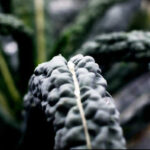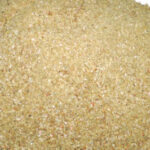One of the most interesting houseplants out there is the prayer plant. The plant’s leaves have a similar structure in comparison to those of a rubber plant, but their coloration is striking and stark. When it comes to indoor plants, prayer plants are sure to accent any area.
While the prayer plant may be slightly more difficult to care for than pothos or philodendron, it’s prayer plant care isn’t difficult. Careful attention to what your plant needs and how it lives in the wild will guide you. With the right knowledge and action you’ll help your prayer plants thrive.
So let’s discuss the prayer plant, pinpoint some varieties, prayer plant propagation, and cover how to give it just what it needs. All this, so you can grow your own at home!
Subscribe to the Epic Gardening Podcast on iTunes or Spotify
Quick Care Guide
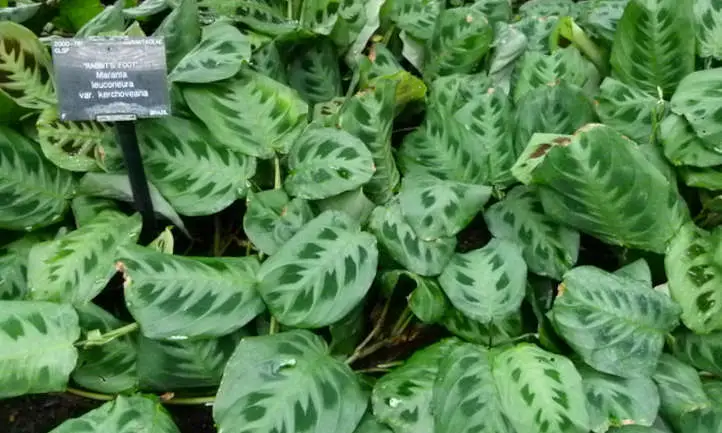
| Common Name | Prayer plant, praying hands |
| Scientific Name | Maranta leuconeura |
| Family | Marantaceae |
| Height & Spread | Up to 3 feet tall, 1 foot wide |
| Light | Bright, indirect sun |
| Soil | Well-draining soil |
| Water | Once per week |
| Pests & Diseases | Spider mites, mealy bugs, aphids, fungus gnats, thrips, leaf spot, root rot |
All About Prayer Plants
The prayer plant (Maranta leuconeura) is a slow growing evergreen perennial in the arrowroot (Marantaceae) family. All prayer plants are native to the tropical rainforests of Brazil, South America. Their common name was assigned due to their their propensity to rise toward the sun as it sets, and fall back toward the earth as it rises.
The structure of prayer plants is incredible, with ovular, broad leaves that have defined veins of varying colors. Usually the central vein is a different color than those that branch to the leaf margins. The foliage of these plants is waxy, and their undersides are a matte grey-green. The leaves of the prayer plant alternate in an elliptical fashion on stiff, rubbery stems.
The overall structure of the plant is bushy, but it can serve as a ground cover in certain tropical areas. At the height of the growing season, the prayer plant flowers small white to purple blooms that grow in pairs on a single inflorescence. The prayer plant flower has a structure somewhat like a cross between a pansy and a half flower, and produces a single seed after it dies away. The roots of prayer plants are thick and branch out below the plant.
These plants are sometimes confused with Calathea orbifolia, which shares a common name with the topic of this piece. Prayer plants are great for homes full of kids and/or pets because they aren’t toxic. They’re also excellent for air purification, removing a significant amount of CO2 from whatever room they’re in. Prayer plant propagation is easy and fun. There are plenty of varieties to choose from too!
Prayer Plant Varieties
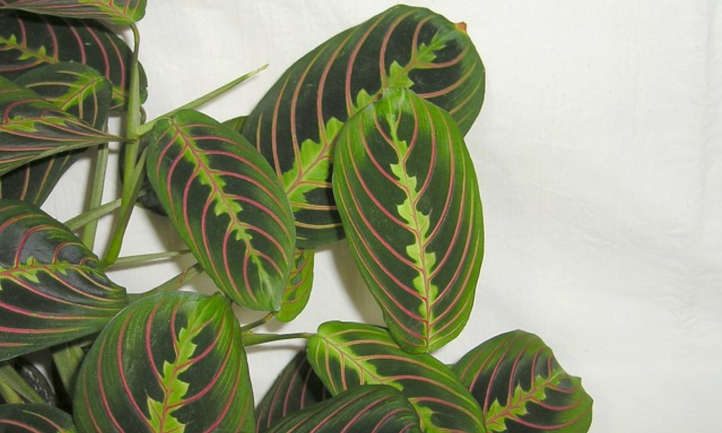
The varieties we discuss here aren’t specifically maranta plants. These are the most common of the 40 to 50 prayer plant types out there right now.
- Red prayer plant, Red maranta: the classic variety with lush deep green leaves and bright red veins. The center vein is surrounded by cream splotches.
- Maranta leuconeura var. leuconeura, ‘Black Prayer Plant’: grey to olive green leaves, a silvery midvein, silver branching veins, and a red center that surrounds the midvein. Blooms white flowers.
- Maranta leuconeura ‘Kim’: with varying shades of green, the leaves of this prayer plant have purple spots, and a cream-white streak for extra flair.
- Maranta leuconeura ‘Marisela’: this prayer plant’s leaves are a lighter shade of green, and the markings are an even lighter green — almost a cream-green color.
- Maranta leuconeura var. erythroneura, ‘Herringbone Plant’, ‘Lemon Lime Prayer Plant’, ‘Lemon Lime Maranta’: alternating colors of deep green and light green leaves and lighter veins.
- Ctenanthe burle-marxii, ‘Fishbone Prayer Plant’: named for the bright almost white veins that run the length of the oval leaves. Not technically a maranta but extremely similar.
- Stromanthe sanguinea, ‘Tri-Colored Prayer Plant’: differs greatly in structure when compared to maranta. Long, starkly streaked leaves with pops of cream, pink, and varying shades of green. The leaf texture on these plants is very waxy.
Prayer Plant Care
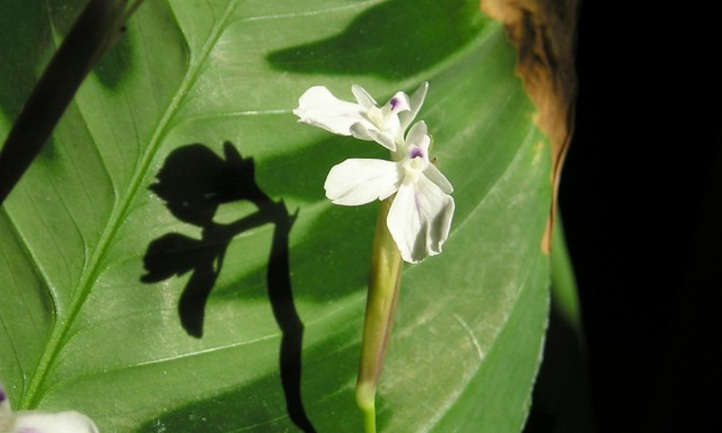
Now that we’ve discussed types of prayer plants, let’s cover the basic care for the prayer plant – maranta species only. Then you’ll know just how to care for your slow grower in a container or hanging basket.
Sun and Temperature
Direct sun or too much sun scorches the leaves of the prayer plant and may kill it. These plants prefer 6 to 8 hours of bright indirect light during the day. They’re tolerant of low light areas, as long as there is good air flow. Keep your plant out of direct sunlight near a window that receives bright light, or in an area of your garden that gets indirect sunlight. Low light conditions won’t hurt them, but these slow growers may do better where they receive enough light to have significant growth. They are hardy in USDA zones 10b to 11, where temperatures sit right within the plants’ tolerance range of 60°F to 85°F. Keep them in normal household temperatures, and do not put them in areas where the temperature drops below 60°, as this can easily kill them. Keep them indoors during that time.
Water and Humidity
Prayer plants do not like to be dry, and prefer moist soil all of the time. That means you’ll likely have a watering routine that includes frequent watering in brighter light. Allow the soil to dry out slightly between watering. Water at the soil surface, but never let the plant’s roots get soggy. When you water prayer plant, use room temperature water. In the winter, reduce watering as your prayer plant goes dormant. You may have heard that some houseplants are picky and preferred filtered or distilled water. This is one of those plants. They also need high humidity at 50% to 60%. To maintain this high humidity, keep a humidifier nearby or mist your plant with a spray bottle filled with distilled water lightly daily. Do not leave your plant in standing water and ensure the pot you’re using has a drainage hole, as this can create conditions where disease can proliferate.
Soil
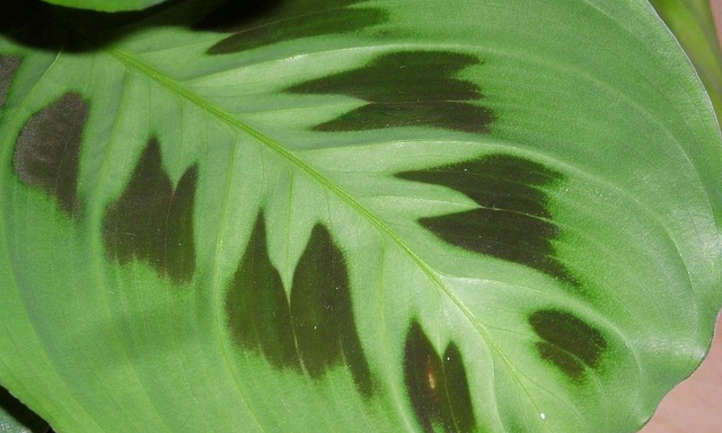
A general purpose houseplant potting soil is great for prayer plants, as long as it is well-draining. If you’re using soil that doesn’t drain well, add perlite or coarse sand to the mixture. To mix your own soil for prayer plants, use 1 part each perlite or coarse sand, garden soil, 1 to 2 parts sphagnum peat moss or coconut coir, and 1 pinch of lime dust. The coard ingredients along with peat moss and coir are enough to retain moisture levels and keep your well-draining soil moist, but not so much that they’ll give your plant wet feet. To improve drainage, add rocks or gravel to the bottom of your pot and be sure that it has adequate drainage holes. Poor soils are not desirable for prayer plants. The optimal pH range is 5.5 to 6.0.
Fertilizing Maranta leuconeura
During the growing season of spring through fall, prayer plants should be fed every two weeks. Use a high quality water-soluble fertilizer with an NPK of 10-15-10. In winter, fertilize less or not at all as conditions are not conducive to growth. Too much fertilizer at this time will create conditions for disease.
Pruning Prayer Plants
If you want to make your prayer plant bushy, prune it. Use a sterilized pair of garden scissors and clip the stems right above a leaf node. The prayer plant will respond by sending out new shoots directly below the cut area, making for a bushier appearance! Do this 2 to 3 times per year in fall and early spring before your plants’ growth season. Remove any diseased parts as they crop up.
Repotting
You won’t need to re-pot your prayer plant much at all. However, when it becomes root-bound, it will grow much slower. To re-pot, choose a container that is 1 to 2 inches wider than the existing pot. Remove your prayer plant from the current pot and put it in the new pot with a bit of extra soil mix. Water well and your prayer plant will grow easily.
Prayer Plant Propagation
Propagating prayer plant is easy! Create a new plant from cuttings or slips in early spring. While prayer plant propagation is possible via seeds, it’s not as reliable. Take stem cuttings below the leaf node, and dip them in rooting hormone. Place the stem cuttings in water in low light conditions, changing the water every couple of days. Place the cuttings in shallow pots with soil when new roots have grown. Keep the soil moist and when new growth appears, you know your propagation was successful.
To propagate prayer plants by slips, take your healthy plants out of their pot, and dust the soil off their roots. Each of the stems should have set of roots you can separate from the others. Then plant these in new soil, and keep them in a humid environment. In several weeks you’ll have new tropical plants you can keep in hanging baskets or containers.
Troubleshooting
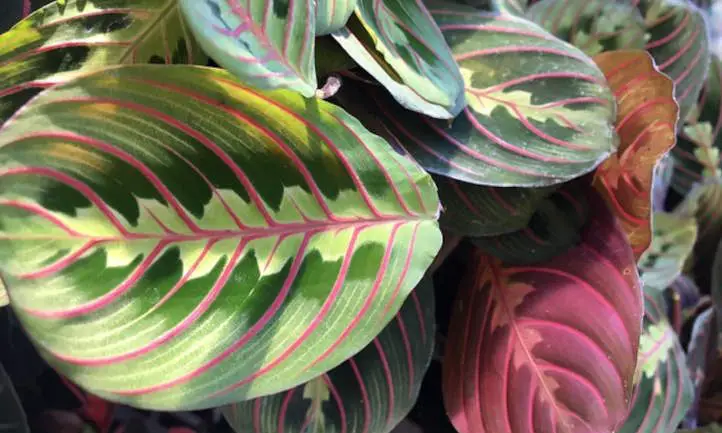
There are a few common pests and diseases that affect prayer plants, and we’ll take some time to cover those now. While most of these are rare, it’s important to be aware of them and act appropriately if they arise.
Growing Problems
If your prayer plants have brown leaf tips or brown leaves, ensure you don’t have them in an area where they are getting too much sun. If you have wilting or yellow leaves, check that your plant is getting enough fertilizer. The vast majority of prayer plant problems are related to a lack of humidity or soil moisture. Alternatively, soggy brown tips on the plant’s leaves may be related to inadequate drainage holes in your container. If so, find another container with better drainage, and repot the plant.
Pests
Spider mites, aphids, and thrips suck the sap from prayer plants, causing lesions and limiting nutrient availability to your plant. If you see webs that these mites weave, or the prayer plant leaves curling, use neem oil to get rid of these congregating insects.
Fungus gnats are more common indoors than out. While the adult form of these pests don’t harm your prayer plant, they can lay eggs that hatch root-hungry larvae. You can dilute neem in water, and irrigate your plants with it every week or so to kill any eggs or larvae.
Mealybugs are tiny cotton ball bugs that suck plant sap. To get rid of them, pop them off your plant with a q-tip soaked in rubbing alcohol. Then mist your plant with insecticidal soap to prevent any further infections.
Diseases
Leaf spot is a fungal disease that can affect prayer plants in overly wet conditions. Water soaked lesions are a sign this disease has set in. If this occurs, move your prayer plant away from other plants to prevent the spread of this disease. Neem will kill an existing infection. Reduce watering and misting to prevent further infection.
Root rot is another disease caused by fungi that love temperate and wet conditions. Mushy stems and leaves are an indication your plant is experiencing rot. Reduce watering and misting to prevent the rot from spreading througout the plant. Remove any damaged leaves or stems. If the problem persists even after this, you may have to start over with a new plant.
Frequently Asked Questions
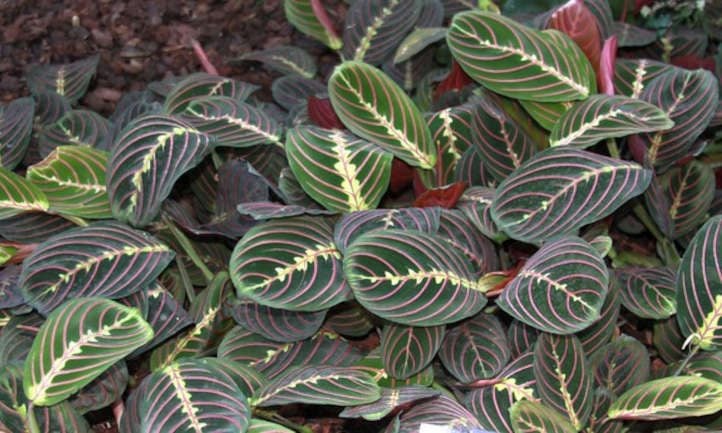
Q: What is special about prayer plant?
A: It rises as the sun sets and lowers when it rises, emulating praying hands.
Q: How do you take care of a praying plant?
A: That’s what this whole piece is about! Give it the right care and you’re all good.
Q: Is prayer plant good for indoor?
A: Yes, it’s best indoors in most USDA zones.
Q: Where do you place a prayer plant?
A: Put it in indirect, yet bright light.
Q: How long does a prayer plant live?
A: It can live for up to 30 years!
Q: How often should I water my prayer plant?
A: Once every week or so in the growing season and once every 2 to 3 weeks in dormancy.
Q: Can I put my prayer plant outside?
A: If temperatures remain between 60° F and 85° F, yes!
Q: Do prayer plants clean the air?
A: They remove CO2 from the air.
Q. How do I keep the humidity high enough for my prayer plant to thrive?
A daily misting can help provide the prayer plant with the humidity it needs that may not be present in your home. You can also set a container of water near the prayer plant, as the evaporating water will increase the humidity.
Q. The leaves of my prayer plant are curling even in the daytime…what’s going on?
It’s a sign conditions aren’t ideal, so try less light throughout the day, and examine the root zone for a healthy medium amount of moisture in the soil.
Q. I’m having problems with the soil for my prayer plant. What should I change?
Prayer plants love soil conditions that drain well, so you should probably add some gravel, perlite, or coarse sand to increase drainage. Be sure you’re not over-watering and that your container has a drainage hole.





